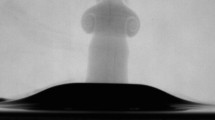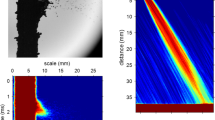Abstract
This study examined the transient behavior of liquid films and the flow of inner gas. Olive oil particles were inserted into a soap bubble through a Laskin nozzle for visualization, and the inner gas flow fields were measured by time-resolved particle image velocimetry. A pulse laser was used for contactless rupturing of the soap bubble. The transient behavior of the liquid film after the soap bubble ruptured was captured using a high-speed camera at 3,600 frames per second. After rupturing the soap bubble, the inner gas flowed out to the outside through the crack. This is called the primary flow. The removal velocity of the upper liquid film was faster than that of the bottom liquid film. The Kelvin–Helmholtz vortex was generated at the upper and bottom boundaries of the liquid film. A series of Kelvin–Helmholtz vortices, which arise in shear flow along a contact discontinuity, were formed around the bubble sphere. Secondary flow was generated due to a change in momentum after impinging the soap film to a point, and was faster than primary flow.
Graphical Abstract







Similar content being viewed by others
References
Afanasyev YD, Andrews GT, Deacon CG (2011) Measuring soap bubble thickness with color matching. Am J Phys 79(10):1079–1082
Arscott S (2013) Wetting of soap bubbles on hydrophilic, hydrophobic and superhydrophobic surfaces. Appl Phys Lett 102(25):254103
Caillier F, Oswald P (2006) Collapse dynamics of smectic-A bubbles. Eur Phys J E 20(2):159–172
Chen J, Qian H, Han B, Shen Z-H, Lu J, Ni X-W (2012) Investigation of collapse features of a bubble near target surface of different sizes for underwater laser propulsion. In Photonics and Optoelectronics (SOPO), 2012 Symposium on. IEEE: pp 1–4
Culick FEC (1960) Comments on a ruptured soap film. J Appl Phys 31:1128–1129
Debregeas G, de Gennes PG, Brochard-Wyart F (1998) The life and death of “Bare” viscous bubbles. Science 279(5357):1704–1707
Harwood IA, Turnock SR, Ashleigh MJ (2013) When bubbles burst: mimetic insights into minimising confidentiality breaches. Eur Manag J 32(1):84–90
Ishizuka S, Tsuji H (1981) An experimental study of inert gases on extinction of laminar diffusion flames. Eighteenth Int Symp Combust 18(1):695–703
Jaw SY, Chen CJ, Hwang RR (2007) Flow visualization of bubble collapse flow. J Vis 10(1):21–24
Keane R, Adrian R (1990) Optimization of particle image velocimeters. Part I: double pulsed systems. Meas Sci Technol 1(11):1202–1215
Kodama T, Tomita Y (2000) Cavitation bubble behavior and bubble-shock wave interaction near a gelatin surface as a study of in vivo bubble dynamics. Appl Phys B 70(1):139–149
Lawson NJ, Rudman M, Guerra A, Liow JL (1999) Experimental and numerical comparisons of the break-up of a large bubble. Exp Fluids 26:524–534
Lee H, Gojani AB, Han TH, Yoh JJ (2011) Dynamics of laser-induced bubble collapse visualized by time-resolved optical shadowgraph. J Vis 14(4):331–337
Muller F, Kornek U, Stannarius R (2007) Experimental study of the bursting of inviscid bubbles. Phys Rev E 75(6):065302
Murashita T, Torikai H, Ito A (2012) Flow visualization of extinguishing gas released from bursting soap bubbles. Visualization of mechanical process 2: issue 2
Ortiz-Villafuerte J (2013) Three-dimensional PIV measurements of bubble drag and lift coefficients in restricted media. Rev Mex Fis 59(5):444–452
Torikai H, Murashita T, Ito A, Metoki T (2011) Extinguishment of a laminar jet diffusion flame using a soap bubble filled with nitrogen gas. Fire safety science-proceedings of the tenth international symposium, pp 557–568
Weaire D et al (1999) The physics of foams. Oxford University Press, New York, p 21
Xiong Y-L, Fischer P, Bruneau C-H (2012) Numerical simulations of two-dimensional turbulent thermal convection on the surface of a soap bubble. Proc ICCFD 7:3703
Acknowledgments
This study was supported by the National Research Foundation of Korea (NRF) Grant funded by the Korea government (MSIP) (No. 2011-0030013 (GCRC-SOP) and No. 2012R1A2A4A01008749), as well as by Korea Institute of Energy Technology Evaluation and Planning (KETEP) granted financial resource from the Ministry of Trade, Industry & Energy, Republic of Korea (No. 20132020000390).
Author information
Authors and Affiliations
Corresponding author
Rights and permissions
About this article
Cite this article
Kim, D., Yi, S.J., Kim, H.D. et al. Visualization study on the transient liquid film behavior and inner gas flow after rupture of a soap bubble. J Vis 17, 337–344 (2014). https://doi.org/10.1007/s12650-014-0217-2
Received:
Revised:
Accepted:
Published:
Issue Date:
DOI: https://doi.org/10.1007/s12650-014-0217-2




